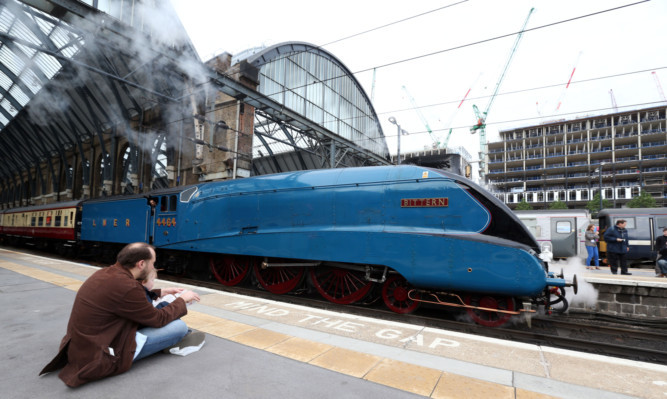Rail enthusiasts gathered to see a historic locomotive mark a milestone as it raced up the East Coast Main Line at the fastest speed travelled by a steam train in almost half a century.
Bittern, an A4-class engine which was built in 1937 and is almost identical to the world’s fastest steam loco, Mallard, began a journey to York from London’s King’s Cross during which it was expected to hit 90mph.
The run commemorates Mallard setting a record speed of 126mph near Grantham on July 3 1938 – a feat that remains unbeaten 75 years later.
Bittern, which was carrying 250 passengers, was granted special permission by authorities to exceed the 75mph limit for steam trains.
Richard Corser, general manager at organiser Locomotive Services Ltd, said: “Today is the culmination of a lot of months of preparation to make this happen, to go at a high speed and to give the passengers a bit of a flavour of what high- speed steam was like.
“This country’s very famous for its engineering skills and steam was its cradle.
“We are very proud of steam heritage and railways in this country and this was shown again today by the support we have received.”
Organisers said they expected the journey to be the fastest a coal-burning locomotive has travelled since steam was phased out in the late 1960s.
Bittern arrived at platform 4 at King’s Cross shortly after 7.30am with trainspotters excited to see steam return to the north London station.
The dining service left for York at 8.18am, where it was due to arrive at platform 10 at 12.25pm after stopping at Potters Bar, Hertfordshire, to pick up more passengers.
Two other long-distance services are planned for Bittern in July, including Bristol to Newcastle-upon-Tyne and another London-to-York run.
Bittern and Mallard are two of 35 A4s designed by renowned engineer Sir Nigel Gresley and built for LNER in Doncaster in the 1930s.
Only six survive, and they are being reunited at the National Railway Museum in York to celebrate the 75th anniversary of Mallard’s record.
The event from July 3, called the Great Gathering, has been billed as a “once-in-a-lifetime sight”.
“What we’re planning is a major celebration – people will be coming from four corners of the Earth,” said Anthony Coulls, the museum’s senior curator of rail vehicle collections.
“The gathering of the six locomotives is the jewel in the crown, really.”
The survivors include Dominion of Canada, which now sits next to Mallard at the National Railway Museum after it was shipped from Montreal last October and restored especially for the anniversary.
And the Dwight D Eisenhower – another transatlantic expat – has also rolled back into York and been treated to a scrub-up for the occasion.
Union of South Africa and the Sir Nigel Gresley will join them around the museum’s Great Hall turntable.
